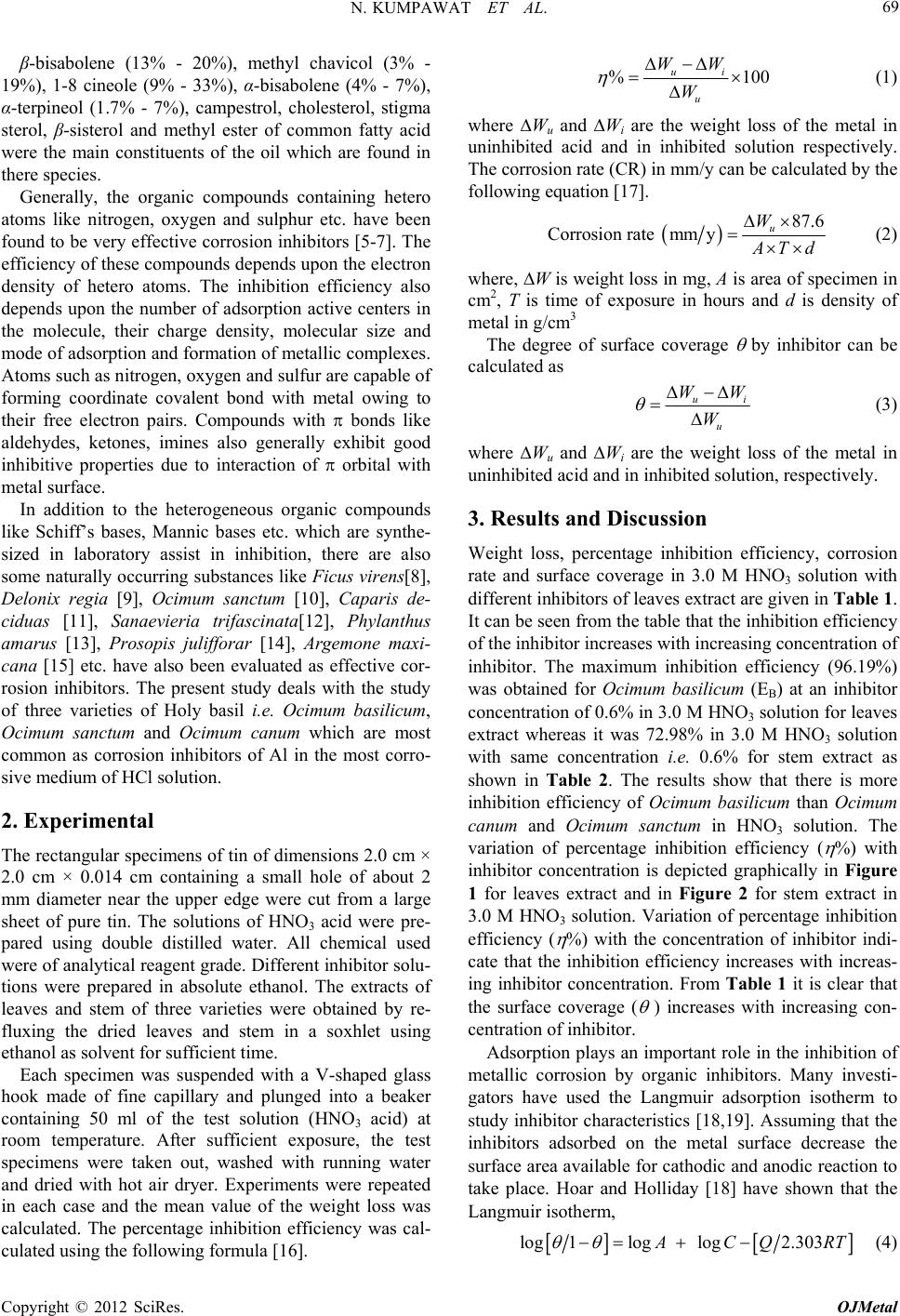
N. KUMPAWAT ET AL. 69
β-bisabolene (13% - 20%), methyl chavicol (3% -
19%), 1-8 cineole (9% - 33%), α-bisabolene (4% - 7%),
α-terpineol (1.7% - 7%), campestrol, cholesterol, stigma
sterol, β-sisterol and methyl ester of common fatty acid
were the main constituents of the oil which are found in
there species.
Generally, the organic compounds containing hetero
atoms like nitrogen, oxygen and sulphur etc. have been
found to be very effective corrosion inhibitors [5-7]. The
efficiency of these compounds depends upon the electron
density of hetero atoms. The inhibition efficiency also
depends upon the number of adsorption active centers in
the molecule, their charge density, molecular size and
mode of adsorption and formation of metallic complexes.
Atoms such as nitrogen, oxygen and sulfur are capable of
forming coordinate covalent bond with metal owing to
their free electron pairs. Compounds with bonds like
aldehydes, ketones, imines also generally exhibit good
inhibitive properties due to interaction of orbital with
metal surface.
In addition to the heterogeneous organic compounds
like Schiff’s bases, Mannic bases etc. which are synthe-
sized in laboratory assist in inhibition, there are also
some naturally occurring substances like Ficus virens[8],
Delonix regia [9], Ocimum sanctum [10], Caparis de-
ciduas [11], Sanaevieria trifascinata[12], Phylanthus
amarus [13], Prosopis julifforar [14], Argemone maxi-
cana [15] etc. have also been evaluated as effective cor-
rosion inhibitors. The present study deals with the study
of three varieties of Holy basil i.e. Ocimum basilicum,
Ocimum sanctum and Ocimum canum which are most
common as corrosion inhibitors of Al in the most corro-
sive medium of HCl solution.
2. Experimental
The rectangular specimens of tin of dimensions 2.0 cm ×
2.0 cm × 0.014 cm containing a small hole of about 2
mm diameter near the upper edge were cut from a large
sheet of pure tin. The solutions of HNO3 acid were pre-
pared using double distilled water. All chemical used
were of analytical reagent grade. Different inhibitor solu-
tions were prepared in absolute ethanol. The extracts of
leaves and stem of three varieties were obtained by re-
fluxing the dried leaves and stem in a soxhlet using
ethanol as solvent for sufficient time.
Each specimen was suspended with a V-shaped glass
hook made of fine capillary and plunged into a beaker
containing 50 ml of the test solution (HNO3 acid) at
room temperature. After sufficient exposure, the test
specimens were taken out, washed with running water
and dried with hot air dryer. Experiments were repeated
in each case and the mean value of the weight loss was
calculated. The percentage inhibition efficiency was cal-
culated using the following formula [16].
% 100
ui
u
WW
W
(1)
where Wu and Wi are the weight loss of the metal in
uninhibited acid and in inhibited solution respectively.
The corrosion rate (CR) in mm/y can be calculated by the
following equation [17].
87.6
Corrosion rate mmyu
W
Td
(2)
where, W is weight loss in mg, A is area of specimen in
cm2, T is time of exposure in hours and d is density of
metal in g/cm3
The degree of surface coverage
by inhibitor can be
calculated as
u
u
WW
W
i
(3)
where Wu and Wi are the weight loss of the metal in
uninhibited acid and in inhibited solution, respectively.
3. Results and Discussion
Weight loss, percentage inhibition efficiency, corrosion
rate and surface coverage in 3.0 M HNO3 solution with
different inhibitors of leaves extract are given in Table 1.
It can be seen from the table that the inhibition efficiency
of the inhibitor increases with increasing concentration of
inhibitor. The maximum inhibition efficiency (96.19%)
was obtained for Ocimum basilicum (EB) at an inhibitor
concentration of 0.6% in 3.0 M HNO3 solution for leaves
extract whereas it was 72.98% in 3.0 M HNO3 solution
with same concentration i.e. 0.6% for stem extract as
shown in Table 2. The results show that there is more
inhibition efficiency of Ocimum basilicum than Ocimum
canum and Ocimum sanctum in HNO3 solution. The
variation of percentage inhibition efficiency (
%) with
inhibitor concentration is depicted graphically in Figure
1 for leaves extract and in Figure 2 for stem extract in
3.0 M HNO3 solution. Variation of percentage inhibition
efficiency (
%) with the concentration of inhibitor indi-
cate that the inhibition efficiency increases with increas-
ing inhibitor concentration. From Table 1 it is clear that
the surface coverage (
) increases with increasing con-
centration of inhibitor.
Adsorption plays an important role in the inhibition of
metallic corrosion by organic inhibitors. Many investi-
gators have used the Langmuir adsorption isotherm to
study inhibitor characteristics [18,19]. Assuming that the
inhibitors adsorbed on the metal surface decrease the
surface area available for cathodic and anodic reaction to
take place. Hoar and Holliday [18] have shown that the
Langmuir isotherm,
log1log log2.303
CQ RT
(4)
Copyright © 2012 SciRes. OJMetal